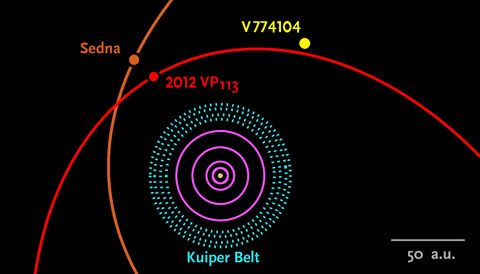V774104: Solar System’s Most Distant Object
An ultra-deep survey has turned up a sizable object situated nearly 10 billion miles from the Sun — more distant than any known solar-system object.
Prowling the outer Kuiper Belt for large, distant members of our solar system has turned up a zoo of remarkable finds in recent years. There's Eris, for example which triggered a divisive debate about Pluto's planetary status; Sedna, whose orbit carries it out to more than 900 astronomical units (1 a.u. is the mean Earth-Sun separation); and 2007 OR10, both very distant (87 a.u.) and one of the reddest objects in the solar system.

This animation of two discovery images for the very distant solar-system object V774104 show it shifting with respect to background stars. This is not from the object's orbital motion, which is far too slow, but rather due to parallax as Earth shifted its location between the two exposures. The frame is 0.7 arcminute wide.
S. Sheppard / C. Trujillo / D. Tholen / Subaru Telescope
S. Sheppard / C. Trujillo / D. Tholen / Subaru Telescope
But at last week's meeting of the American Astronomical Society's Division for Planetary Sciences, Scott Sheppard (Carnegie Institution for Science) announced that he, Chad Trujillo (Gemini Observatory), and David Tholen (University of Hawai'i) have spotted something even farther from the Sun. This body, designated V774104 for now, lies 103 a.u. away in the direction of west-central Pisces — that's 9.6 billion miles or 15.4 billion km.
The object turned up in a pair of images taken October 13th with Japan's 8-meter Subaru Telescope atop Mauna Kea. The animation at upper right shows the motion of V774104 in the 5½-hour interval between the two images. "We detect the motion of solar system objects by parallax and not by the actual movement of the object," Sheppard explains. An object around 100 a.u. away will shift about 1.3 arcseconds per hour, he says, so it's easily detected in a few hours.
V774104 is so distant that it will take another year of study to determine its orbit. "All we really know is the distance," Sheppard admits, along with a guess as to its size. Given its brightness — just 24th magnitude — and assuming that its surface is 15% reflective, the object might be 500 km across. The researchers will make follow-up observations in early December with one of the 6.5-m Magellan telescopes in Chile.
What Kind of Orbit?
Dynamicists will be eager to learn what kind of orbit V774104 occupies. A highly eccentric track would mean that it periodically swings much closer to the Sun. That's the case with Eris, which likely got flung into its 558-year-long orbit after a gravitational encounter with Neptune eons ago.

Beyond its distance and estimated size, astronomers know little about the distant object V774104. Within a year, they hope to determine the characteristics of its orbit around the Sun (small yellow dot at center). The outermost pink circle denotes Neptune's orbit.
Source: Scott Sheppard / Carnegie Inst. for Science
Source: Scott Sheppard / Carnegie Inst. for Science
But if the orbit is more circular, or if V774104 was found near perihelion, then it's completely decoupled from the massive planets — and that will cause dynamicists to question how it got out there. Two other distant objects, Sedna and 2012 VP113, are also in this kind of orbital limbo. There's no consensus on why they're out there; possible causes run the gamut from gravitational stirring of the even more distant Oort Cloud by a close-passing star to the presence of an undiscovered massive planet far beyond the orbit of Neptune. Or they might be the first-found members of the inner Oort Cloud.
Meanwhile, the search goes on for Sheppard, Trujillo, and Tholen. They're using the Subaru Telescope and the 4-m Blanco Telescope at Cerro Tololo Inter-American Observatory to conduct the largest, deepest survey to date for distant solar-system objects. They hope to find more Sedna-like objects — and Sheppard tells me they've spotted several more objects lying 80 to 90 a.u. away that are being tracked. Should all of these turn out to share orbital characteristics, it would imply that a massive planet awaits discovery in the distant solar system.
No comments:
Post a Comment